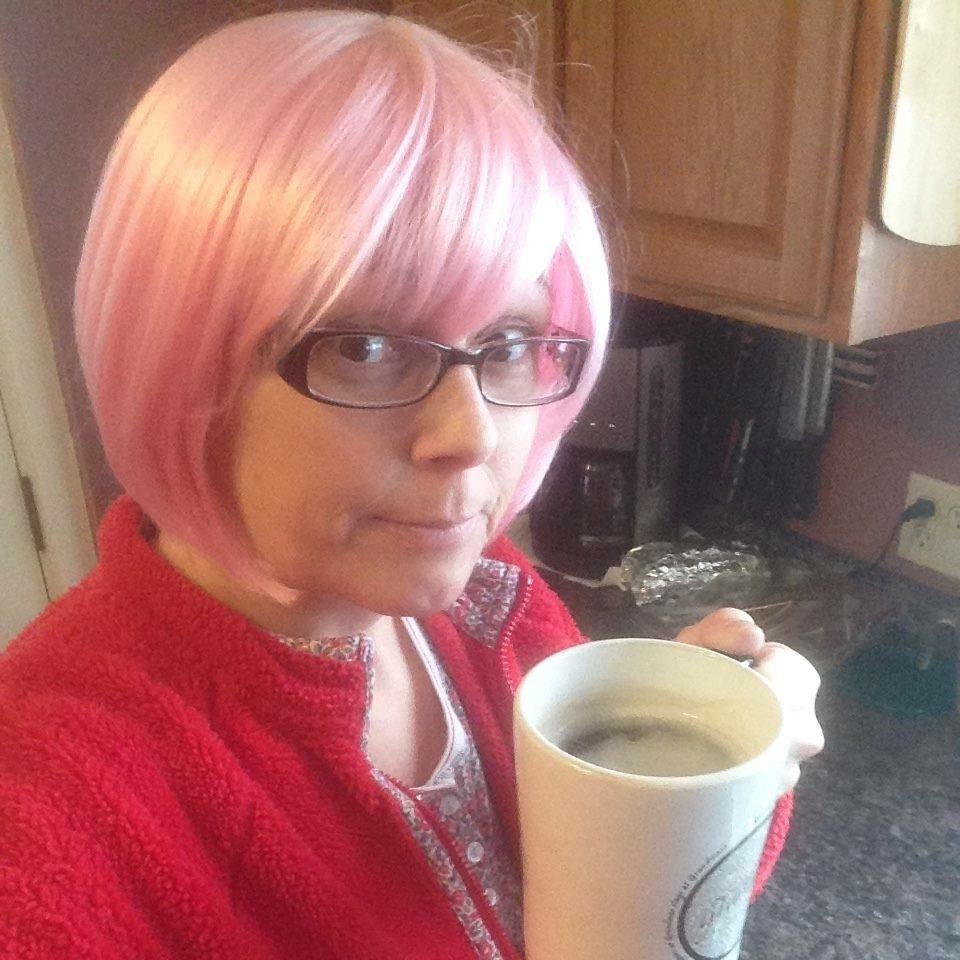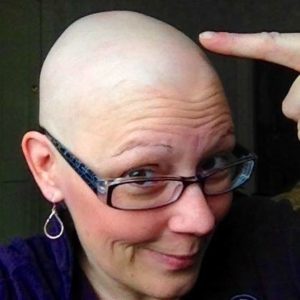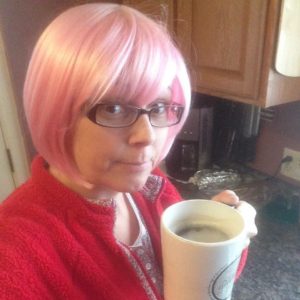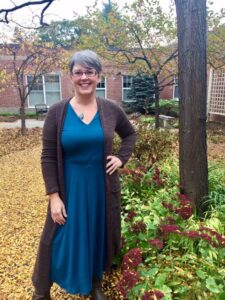
By Maryellen Apelquist
Brenda Caswell is an eighth-generation Vermonter, a happily-married mother of five, and a sales representative for her hometown newspaper. Upon meeting her, one is struck by her warmth, her generous smile, her flattering pixie haircut. She has 1,296 friends on Facebook, and you just know they are friends in real life. Her favorite movie is “It’s a Wonderful Life,” and she loves joining her family each year to pick out a Christmas tree.
Brenda says motherhood “kind of defines me,” which isn’t surprising given that she has two girls and three boys ranging in age from 6 to 29. Being a mom has kept her busy for many years, and taking care of others has been a dominant theme in her life.
But while all outward appearances may point to a charmed life, that’s not all there is to Brenda.
She is also a breast cancer survivor, a vocal breast cancer survivor. One who is happy to answer the most personal of questions as she encourages other women to put themselves first, to get their annual mammograms, to not “put if off.”
A survivor who had a bilateral mastectomy and chemotherapy and, somewhere in the midst of it all, a hysterectomy.
A survivor who lost her stepfather to cancer the day after she met with an oncologist to review her own pathology report.
One who was quarantined for a week during the holidays, due to her weakened immune system, and unable to see her children. Unable to join them for their annual Christmas tree hunt.
And one who, at one point, “couldn’t stop crying for days.”
“If I can help just one person, I need to be loud,” says Brenda. “I think not to talk about breast cancer is crazy. Women should take care of ourselves the way we take care of other people we love.”
Looking Back
Brenda knows firsthand the importance of early detection. She started getting mammograms in her mid-30s, given a family history of breast cancer, and was great about getting one annually—until she wasn’t. Her “surprise baby” came along when she was 42; she remembers that she had a mammogram scheduled but had to cancel because she was breastfeeding.
“I was going to call back and reschedule—that was my plan—but everything to do with being a mom got in the way,” she says. “I was doing all these things but couldn’t remember to do my mammogram.”
Years passed. She made an appointment for a physical with her Gifford primary care provider, who called her out for not having had a mammogram in three years.
“She said, ‘You’re not leaving here until we schedule a mammogram,’” Brenda recalls. “She stood next to me while her nurse made the appointment.”
She had the mammogram in June 2014, and subsequently received a call to come back to the hospital to review the results.
“They started handing me pamphlets, and I just knew. My first thought was, I can handle surgery and radiation, but I don’t want chemo—seeing what it had done to my stepdad.”
“I also felt guilty. I had waited three-and-a-half years. And I thought, if this is cancer, I am going to be really vocal about it. I am going to tell all of my friends. I am going to be really loud about it and try to prevent other people from making the mistake of postponing a mammogram.”
She had a biopsy, then a birthday party for her then 16-year-old daughter. Brenda and her husband, Wally, decided to keep the biopsy under wraps until she received its results.
Wally was with her when a radiologist read the biopsy report, which indicated non-invasive Stage 0 DCIS (ductal carcinoma in situ), “in my milk ducts,” Brenda recalls. “In my mind, I didn’t have cancer, but I was sent home with options—lumpectomy, mastectomy, et cetera. Something in my gut said, I need a mastectomy. Something told me it wasn’t Stage 0. I chose to be pretty radical and do a bilateral mastectomy.”
Brenda had surgery to remove both breasts on Oct. 6, 2014.
“When the pathology report came back, we found out it was not DCIS,” she says. “We learned it was Stage 1, Grade 3, and that the chance of the cancer coming back was 38 percent.”
Brenda met with her oncologist.
“I knew I was in trouble when I walked in,” Brenda says. “She asked, ‘Are you here alone? Do you know why you’re here?’”
Upon hearing the news that she needed further treatment, chemo, Brenda left the office and “cried my eyes out in the parking lot. Then I went home and took care of my stepdad.” She was one of his primary caregivers.
He died the next day.
Brenda was in shock, in mourning, but her treatment plan was already in motion. A week later she had a hysterectomy, which she needed before she could have chemotherapy. She started chemo the first week of December.
On Chemo
 “The first day was the scariest day,” says Brenda. “I was there two or three hours. Wally was there.”
“The first day was the scariest day,” says Brenda. “I was there two or three hours. Wally was there.”
Later, she would be hospitalized for a week.
“I was pretty sick from nausea, which we had a hard time controlling despite all the anti-nausea medications,” Brenda says. “The doctors and nurses had to suit up because my immune system was down, and nobody else could visit me but Wally. I couldn’t help with Christmas gifts. Wally was FaceTime-ing me” while he shopped.
Brenda’s medical team was able to boost her immune system in time for Christmas, which she spent with family.
She continued chemotherapy, the first four treatments of which were three different types of chemo. She started another, Taxol, in February 2015.
“Everything seemed fine, but a week or 10 days later, I was very short of breath. I would get winded walking to the bathroom. I called my oncologist, who sent me in for chest scans. They assumed I had a virus.”
When it came time for her second Taxol treatment, Brenda refused. “My oncologist called the radiologist, who had missed that I actually had pneumonitis. My oncologist really listened to me, though. I felt like my team listened to me at all times. We stopped my treatments.”
Staying Strong
Brenda had regular follow-up appointments after finishing chemotherapy. It would be two years before she heard the words “cancer-free.”
She credits her family, her community, and her attitude for seeing her through.
“I had moments of deep sadness over losing my breasts, over missing my kids’ activities, basketball games, soccer games, so I would give myself an hour to just let go. You do what you have to do, because you just do.”
“Our attitude is just as much a part of our treatment plan as radiation or chemo,” she says. “Positive or negative, it is part of our treatment plan and just as important as the other pieces. We can make it easier on ourselves or harder on ourselves, and I didn’t want to make it harder.”
That’s not to say that Brenda didn’t have dark days, when rallying seemed impossible.
“My oncologist had warned me that, after treatment is over, and everything is done, that at some point in the following months you will fall apart. The wheels fall off. The hard part is over, but you’re finally processing: You had cancer. In our case, we battled it while we also lost my stepdad to it. We weren’t able to grieve him the way we wanted. The kids struggled. I started battling depression.”
But Brenda says there are meaningful signs in life as long as we are open to seeing them: “I woke up one morning and just couldn’t stop crying. I told my husband that I couldn’t find joy anywhere. I left that morning to pick up my daughter from art camp. While chatting with someone at the camp, I noticed an art teacher staring at me in a weird way. She came over and said, ‘I need to give you this.’ It was a bracelet that said ‘joy.’ I was speechless.”
“We must find joy. But it’s also OK for me to grieve for the fact that my life is never going to be the same again.”
The Power of Pink, and Community
 The day before Brenda was hospitalized and quarantined, she went to the movie theater in town to see “It’s a Wonderful Life,” her longtime favorite film, with friends who had never seen it.
The day before Brenda was hospitalized and quarantined, she went to the movie theater in town to see “It’s a Wonderful Life,” her longtime favorite film, with friends who had never seen it.
Why is she such a fan of the Frank Capra classic?
“Because my life is like George Bailey’s,” she says. “I am living his life, with an amazing, supportive community. We didn’t have to cook a meal for almost a year,” thanks to the generosity of neighbors and friends.
“And my kids were troopers. They were great through the whole process.” Her oldest son, who was in Arizona during her treatments, even shaved his head in solidarity.
Still, Brenda says, “I could have saved a lot of fear and frustration if I had been diagnosed earlier. That is why I am always happy to answer questions and talk to people. I am very vocal on Facebook, sharing memories from that time” and encouraging other women to get mammograms.
Brenda also shared her experience, and explained the importance of early detection, during a recent Randolph Union High School “Sea of Pink” cancer-awareness event.
“Pink shirts and pink ribbons are reminders to women to put themselves first,” she says of the signature color that paints campaigns to increase breast cancer awareness.
“We have to take care of ourselves.”
###
Are you a woman over 40? If you or someone you love has been putting off an annual mammogram, the time is now to make an appointment. Early detection is critical: While breast cancer can’t be prevented, “early detection provides the greatest possibility of successful treatment,” according to the National Breast Cancer Foundation. Call your doctor today! (p.s. Did you know Vermont’s Ladies First program covers the cost of a mammogram for women age 21 or older who meet income guidelines? Call 800-508-2222 to see if you’re eligible.)
Have questions about your upcoming mammogram? Call Gifford Patient Care Navigator Brittany Kelton at 802-728-2435. She is happy to help guide you through the process.


